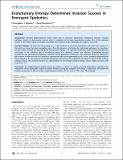| dc.contributor.author | Rhodes, Christopher J. | |
| dc.contributor.author | Demetrius, Lloyd A. | |
| dc.date.accessioned | 2013-10-25T14:09:35Z | |
| dc.date.issued | 2010 | |
| dc.identifier.citation | Rhodes, Christopher J., and Lloyd Demetrius. 2010. Evolutionary Entropy Determines Invasion Success in Emergent Epidemics. PLoS ONE 5(9): e12951. | en_US |
| dc.identifier.issn | 1932-6203 | en_US |
| dc.identifier.uri | http://nrs.harvard.edu/urn-3:HUL.InstRepos:11213395 | |
| dc.description.abstract | Background: Standard epidemiological theory claims that in structured populations competition between multiple pathogen strains is a deterministic process which is mediated by the basic reproduction number (R0) of the individual strains. A new theory based on analysis, simulation and empirical study challenges this predictor of success. Principal Findings: We show that the quantity is a valid predictor in structured populations only when size is infinite. In this article we show that when population size is finite the dynamics of infection by multi-strain pathogens is a stochastic process whose outcome can be predicted by evolutionary entropy, S, an information theoretic measure which describes the uncertainty in the infectious age of an infected parent of a randomly chosen new infective. Evolutionary entropy characterises the demographic stability or robustness of the population of infectives. This statistical parameter determines the duration of infection and thus provides a quantitative index of the pathogenicity of a strain. Standard epidemiological theory based on as a measure of selective advantage is the limit as the population size tends to infinity of the entropic selection theory. The standard model is an approximation to the entropic selection theory whose validity increases with population size. Conclusion: An epidemiological analysis based on entropy is shown to explain empirical observations regarding the emergence of less pathogenic strains of human influenza during the antigenic drift phase. Furthermore, we exploit the entropy perspective to discuss certain epidemiological patterns of the current H1N1 swine 'flu outbreak. | en_US |
| dc.description.sponsorship | Other Research Unit | en_US |
| dc.language.iso | en_US | en_US |
| dc.publisher | Public Library of Science | en_US |
| dc.relation.isversionof | doi:10.1371/journal.pone.0012951 | en_US |
| dc.relation.hasversion | http://www.ncbi.nlm.nih.gov/pmc/articles/PMC2944876/pdf/ | en_US |
| dash.license | LAA | |
| dc.subject | ecology | en_US |
| dc.subject | theoretical ecology | en_US |
| dc.subject | evolutionary biology | en_US |
| dc.subject | evolutionary ecology | en_US |
| dc.subject | infectious diseases | en_US |
| dc.subject | epidemiology and control of infectious diseases | en_US |
| dc.subject | viral infections | en_US |
| dc.title | Evolutionary Entropy Determines Invasion Success in Emergent Epidemics | en_US |
| dc.type | Journal Article | en_US |
| dc.description.version | Version of Record | en_US |
| dc.relation.journal | PLoS ONE | en_US |
| dash.depositing.author | Demetrius, Lloyd A. | |
| dc.date.available | 2013-10-25T14:09:35Z | |
| dash.affiliation.other | FAS^FMUS^MCZ Research - Other Academic | en_US |
| dc.identifier.doi | 10.1371/journal.pone.0012951 | * |
| dash.contributor.affiliated | Demetrius, Lloyd | |


